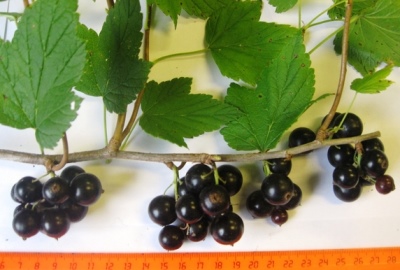
- Authors: T. V. Shagina, E. M. Chebotok (Federal State Budgetary Scientific Institution "Ural Federal Agrarian Research Center of the Ural Branch of the Russian Academy of Sciences")
- Appeared when crossing: free pollination of the Valovaya variety
- Year of approval: 2015
- Ripening terms: medium late ripening
- Growth type: tall
- Yield: high
- Appointment: universal
- Berry weight, g: 1,6-5
- Tasting assessment: 4.1 points
- Escapes: medium, straight, light green, hairless, matte
Currant Fortuna, indeed, can become a "gift of the gardener's destiny." However, not everything is as simple as it seems - you will have to thoroughly prepare and debug everything, master the principles. And we must also pay attention to the key features of the plant itself.
Breeding history
Fortune was created in the Urals. More precisely, at the Federal Agrarian Research Center. The creators of the culture are the breeders Shagin and Chebotok. We got a new variety by free pollination of Gross currant, and not by hybridization. The shrub has been allowed to grow on private farms since 2015.
Description of the variety
Fortune is a good black currant. It has versatile horticultural applications. Bushes of this type reach great heights. They are moderately spreading and not too dense. Shoots are of medium thickness, growing straight.
The shoots are characterized by a light green color. They also have a matte sheen and are completely devoid of the gun. Large greenish leaves, again, are matte in color. A soft smooth surface is typical for them. Clusters reach medium length, fruits are not grouped too tightly in them.
Characteristics of berries
The black Fortuna berries are almost uniform in size. They are great. The mass of one specimen can range from 1.9 to 5 g. A typical feature of the fruit is a simple round shape. In general, they are not inferior to the yield of various competing varieties.
Taste qualities
The thick and glossy rind of the Fortuna fruit does not leave an unpleasant impression. The taste range combines sour and sweet notes. The proportion of sugars is 8.4%, and the concentration of acids reaches 3.1%. The tasting score is 4.1 points. Lowered it due to high acidity. The crop will not smell too strong.
Ripening and fruiting
The variety belongs to the mid-late category. They note its early maturity. The berries will take a long time to form.

Yield
On average, the productivity of a plant is 37.1 centners per hectare. Its maximum level is 200 centners. Such a wide range emphasizes the importance of both weather and agrotechnical measures.
Growing regions
The plant was zoned for the Volga-Vyatka region. Cultivation in other areas of Russia is not very justified.
Self-fertility and the need for pollinators
Fortune is self-fertile. The self-pollination rate is 63%. Therefore, you can refuse extraneous bushes, but they can help a little.
Landing
Fortune develops well both in sunny places and in partial shade. The plant is not too demanding on soil fertility. However, you can get the best yields only on thoroughly moistened productive land. Loam or sandy loam are optimal. Light texture is very important.

Growing and caring
During dry periods, Fortuna currants should be watered weekly. At the same time, water consumption reaches 30 liters per 1 bush. Moisturizing is especially important when berries are tied and poured with ripeness. In the first two years of development, fertilizer may not be applied. Then, during the season, key mineral dressings are added to the soil 3-4 times. Nitrogen mixtures should not be applied in the second half of summer and autumn.




Disease and pest resistance
In general, this resistance is at an average level. Excellent immunity against powdery mildew and kidney mites is noted. The index of immunity to septoria is 1.5 points.

Currant is one of the most favorite crops of gardeners, it can be found on almost any personal plot. In order for the currant berries to be tasty and large, and the bush itself to be healthy and strong, you should properly care for, treat and protect the plant from harmful insects. It is important to recognize the signs of the disease in a timely manner and begin treatment in the early stages of plant damage.
Resistance to adverse climatic conditions
Fortune is doing well in a relatively cold time. However, it can also be stably maintained in hot conditions. Even a dry time is not too dangerous for culture. However, at the same time, you still need to take care of the plants so that they give an optimal result.










































































